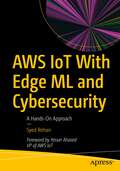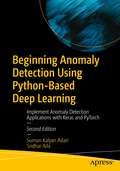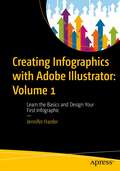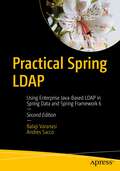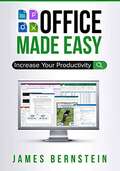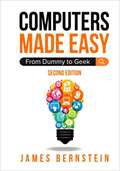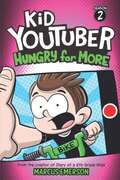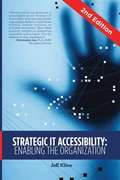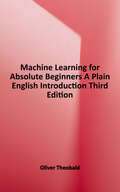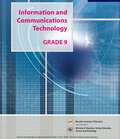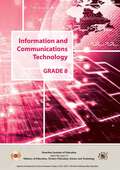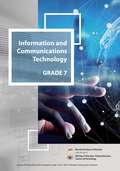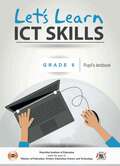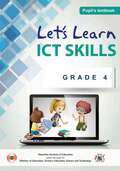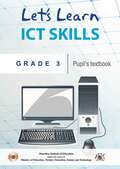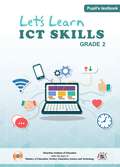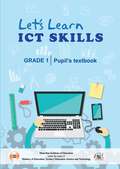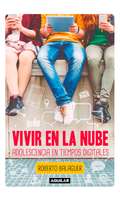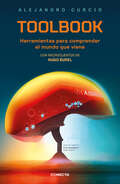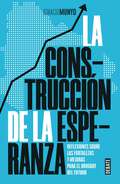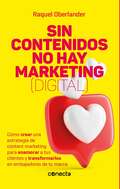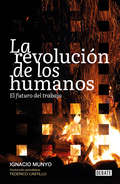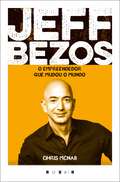- Table View
- List View
AWS IoT With Edge ML and Cybersecurity: A Hands-On Approach
by Syed RehanIn an era where the fusion of connectivity and technology is redefining industries, this book is a must-have guide for aspiring technologists and seasoned professionals alike. This meticulously crafted handbook guides you through every aspect of AWS IoT, touching upon vital spheres such as edge computing, machine learning, and industrial IoT, with a distinct spotlight on cybersecurity. Over the course of this book, industry veteran Syed Rehad unveils the secrets to setting up your AWS IoT environment and walks you through advanced concepts such as leveraging MQTT, mastering Digital Twin implementation, and plumbing the depths of edge machine learning. Whether you're experimenting with virtual devices or hands-on with Raspberry Pi setups, this book will steer you towards innovation and a transformative journey where technology meets intelligence and security, all under the expansive umbrella of AWS IoT. What You Will Learn AWS Mastery: Dive deep into AWS IoT essentials, from setup to hands-on SDK toolsAdvanced Connectivity: Explore advanced MQTT features and the potential of AWS IoT Core MQTT clientsDevice Integration: Master AWS IoT device creation, connection, and deployment, blending the digital and physicalDigital Twin: Unleash IoT's future with AWS IoT device shadow, capitalizing on digital twin technologyDevice Management: Transform remote oversight using secure IoT tunnelling and innovative actionsEdge Development: Merge IoT and Machine Learning via AWS IoT Greengrass, spotlighting image classificationData to Insights: Swiftly move from raw data to actionable insights leveraging Amazon TimestreamIoT Cybersecurity: Strengthen your defenses using AWS IoT Device Defender, Zero Trust principles, and Machine Learning (ML) Detect to prepare for and counter threats Who This Book Is For IoT developers and enthusiasts, professionals who want to implement IoT solutions in industrial scenarios, system architects and designers interested in edge machine learning, business intelligence analysts, and cybersecurity professionals.
Beginning Anomaly Detection Using Python-Based Deep Learning: Implement Anomaly Detection Applications with Keras and PyTorch
by Suman Kalyan Adari Sridhar AllaThis beginner-oriented book will help you understand and perform anomaly detection by learning cutting-edge machine learning and deep learning techniques. This updated second edition focuses on supervised, semi-supervised, and unsupervised approaches to anomaly detection. Over the course of the book, you will learn how to use Keras and PyTorch in practical applications. It also introduces new chapters on GANs and transformers to reflect the latest trends in deep learning. Beginning Anomaly Detection Using Python-Based Deep Learning begins with an introduction to anomaly detection, its importance, and its applications. It then covers core data science and machine learning modeling concepts before delving into traditional machine learning algorithms such as OC-SVM and Isolation Forest for anomaly detection using scikit-learn. Following this, the authors explain the essentials of machine learning and deep learning, and how to implement multilayer perceptrons for supervised anomaly detection in both Keras and PyTorch. From here, the focus shifts to the applications of deep learning models for anomaly detection, including various types of autoencoders, recurrent neural networks (via LSTM), temporal convolutional networks, and transformers, with the latter three architectures applied to time-series anomaly detection. This edition has a new chapter on GANs (Generative Adversarial Networks), as well as new material covering transformer architecture in the context of time-series anomaly detection. After completing this book, you will have a thorough understanding of anomaly detection as well as an assortment of methods to approach it in various contexts, including time-series data. Additionally, you will have gained an introduction to scikit-learn, GANs, transformers, Keras, and PyTorch, empowering you to create your own machine learning- or deep learning-based anomaly detectors. What You Will Learn Understand what anomaly detection is, why it it is important, and how it is appliedGrasp the core concepts of machine learning.Master traditional machine learning approaches to anomaly detection using scikit-kearn.Understand deep learning in Python using Keras and PyTorchProcess data through pandas and evaluate your model's performance using metrics like F1-score, precision, and recallApply deep learning to supervised, semi-supervised, and unsupervised anomaly detection tasks for tabular datasets and time series applications Who This Book Is For Data scientists and machine learning engineers of all levels of experience interested in learning the basics of deep learning applications in anomaly detection.
Creating Infographics with Adobe Illustrator: Learn the Basics and Design Your First Infographic
by Jennifer HarderThis full-color book will teach you how to use Adobe Illustrator's various tools to create infographics, as well as basic page layouts for them. This is the first of three volumes which will cover all the fundamentals of Illustrator, an industry standard application used by graphic designers and marketing and communication teams. How is an infographic different from a logo or any other illustration? What additional thought processes, skills, or software tools should be utilized to create an infographic? In this first volume of Illustrator Basics, you will learn the answers to all these questions. Author Jennifer Harder will walk you through creating basic infographics in Illustrator using Basic Shape tools, Pen Tools, Type Tools, and Symbols. Upon completing this volume, you will have an appreciation for how easy it is to design an infographic and discover how rudimentary shapes and colors can affect readability while conveying meaning to your audience. You will be able to use this knowledge to create your own infographics using Illustrator’s wide array of tools. Who This Book Is For Discover the tools within Illustrator that are ideal for creating basic infographicsDevelop a logo based upon a scanned sketchGain an understanding of different infographic layouts and the process of reviewing them with your client Who This Book Is For Beginner-level designers and others who are interested in learning the process of creating infographics for their company, the classroom, for a visual resume, an article in a magazine, or a webpage.
Practical Spring LDAP: Using Enterprise Java-Based LDAP in Spring Data and Spring Framework 6
by Balaji Varanasi Andres SaccoThis revised edition is your practical, hands-on guide to developing Java-based enterprise applications with big data or batches of data using the Spring LDAP and the Spring Data LDAP frameworks. The book covers these popular Spring project modules and explains the purpose and fundamental concepts of LDAP before giving a comprehensive tour of the latest version of Spring LDAP and Spring Data LDAP as found in Spring Framework 6. The book provides a detailed treatment of LDAP controls and the new features of Spring LDAP such as Object Directory Mapping and LDIF parsing. LDAP has become the de facto standard for storing and accessing information in enterprises. Despite its widespread adoption, developers often struggle when it comes to using this technology effectively. The traditional Java LDAP and JNDI approaches have proven to be painful and have resulted in complex, less modular applications. The Spring LDAP framework provides an ideal alternative.After reading and using this book, you'll come away with a level of comfort for working with large batches of data or big data in your enterprise Spring applications development.What You'll LearnExplore "What is Java LDAP?" and understand the Spring LDAP and Spring Data LDAP frameworksSearch LDAP resourcesSort and page your LDAP resultsDive into object directory mappingHandle LDAP transactions and moreWho This Book Is ForIntermediate to advanced Java and Spring software developers; programmers with at least some prior experience in Java, especially the Spring Framework
Extreme Privacy: What It Takes to Disappear
by Michael BazzellMichael Bazzell has helped hundreds of celebrities, billionaires, and everyday citizens completely disappear from public view. He is now known in Hollywood as the guy that “fixes” things. His previous books about privacy were mostly REACTIVE and he focused on ways to hide information, clean up an online presence, and sanitize public records to avoid unwanted exposure. <p><p>This textbook is PROACTIVE. It is about starting over. It is the complete guide that he would give to any new client in an extreme situation. It leaves nothing out, and provides explicit details of every step he takes to make someone completely disappear, including document templates and a chronological order of events. The information shared in this volume is based on real experiences with his actual clients, and is unlike any content ever released in his other books.
Office Made Easy: Increase Your Productivity (Computers Made Easy)
by James BernsteinLearn How to Use Microsoft Office With This Easy to Follow Step by Step Guide. <p><p>Office Made Easy was written to take your overall office skills from a beginner to the next level of productivity. The book is based on Office 2016 but will apply to Office 2007-2019 since the functionality is basically the same. With this book you will get a top level understanding without a need for a complex education. This easy to use guide will help you navigate your way to becoming proficient with the Microsoft Office Suite of programs.
Computers Made Easy: From Dummy to Geek
by James BernsteinA Foundation in Computers and Software That's Easy to Understand <p><p>Computers Made Easy is designed to take your overall computer skills from a beginner to the next level, and beyond. This book will give you a top level understanding of how to use your PC without a needing a background in computers. This easy to use, step by step guide will help you navigate your way to becoming proficient with computers, operating systems (Windows 10 & 11), hardware and software.
Kid Youtuber 2: From the Creator of Diary of a 6th Grade Ninja (Kid Youtuber #2)
by Marcus Emerson Noah ChildDavy Spencer is still learning the secrets to becoming a superstar YouTuber! In this season, Davy's views skyrocket when he lets Fans decide his next video, but how far will he go to become an internet legend? Answer - VERY, VERY FAR. There’s a food drive at Davy’s school, and the kid who donates the most canned goods by the end of the week wins a super rad bike! Davy promises his Fans a crazy-dangerous stunt with the bike if they help him win it - all they have to do is leave a canned good by his locker with a video idea taped to the top. As the cans pile up, so does Davy’s Fan count, but how high does Davy need to jump to keep his new Fans happy? Kid Youtuber: Hungry for More is a funny children's book for ages 9-12, middle school students, and adults who never grew up. Marcus Emerson is the author of Diary of a 6th Grade Ninja, The Super Life of Ben Braver, and Recess Warriors.
Strategic IT Accessibility: Enabling the Organization
by Jeff KlineThis strategic guide to understanding, enabling, and implementing information technology accessibility across organizations of any size, type, or geographic location, is an essential resource for technology professionals and executives. IT accessibility, or the lack thereof, can have a profoundly positive or negative effect on an organization in the private or public sector. Only when IT accessibility is considered organization-wide can one gain an appreciation for its potential advantages. Drawing on his decades of experience in IT accessibility leadership at IBM and in state government, Jeff Kline clearly articulates how to build and maintain holistic organization-wide IT accessibility programs that integrates IT accessibility into the fabric of your organization’s business, operations, and culture; make your organization’s IT offerings and internal IT environments accessible and inclusive to all audiences.
Machine Learning for Absolute Beginners: A Plain English Introduction (Machine Learning with Python for Beginners)
by Oliver TheobaldThis book provides a high-level introduction to machine learning, free downloadable code exercises, and video demonstrations. Machine Learning for Absolute Beginners Third Edition has been written and designed for absolute beginners. This means plain English explanations and no coding experience required. Where core algorithms are introduced, clear explanations and visual examples are added to make it easy to follow along at home. New Updated Edition. This new edition also features extended chapters with quizzes, free supplementary online video tutorials for coding models in Python, and downloadable resources not included in the Second Edition. Readers of the Second Edition should not feel compelled to purchase this Third Edition.
Information And Communications Technology class 9 - MIE
by Mauritius Institute of EducationThe Grade 9 ICT workbook is meticulously crafted to align with the National Curriculum Framework, recognizing the pivotal role of digital literacy in today's evolving landscape. With a strategic focus on technology's exponential growth, the workbook unfolds across nine comprehensive units, ranging from fundamental computer operations to practical problem-solving and programming. Through a learner-centric approach, the workbook amalgamates theoretical concepts with engaging practical activities, employing games, and exercises that foster hands-on learning experiences. Emphasizing continuous engagement, it encourages a year-long blend of theory and application. Symbolized guides like Tipiyu, carried over from previous grades, enrich the learning journey, while colored elements and symbols serve as aids, enhancing comprehension. Anchored in promoting ICT skills essential for a burgeoning knowledge society, this workbook primes students for the National Examination, nurturing their capacity to navigate digital environments, solve problems, and flourish in an increasingly tech-driven world.
Information and Communications Technology class 8 - MIE
by Mauritius Institute of EducationThe "Information and Communications Technology - Grade 8" textbook, published by the Mauritius Institute of Education in 2021, encompasses nine units covering a wide array of ICT topics. Aimed at Grade 8 students, it delves into fundamental aspects like computer operations, word processing, presentations, spreadsheets, internet usage, multimedia, health, safety, ethics, practical problem-solving, programming, and databases. Serving as a comprehensive guide, it equips students with a strong foundational understanding of ICT principles and skills crucial in today's world. The textbook's clarity and concise presentation facilitate easy comprehension, allowing students to grasp concepts effortlessly. With its detailed coverage and accessible language, this resource proves invaluable for students seeking to explore and comprehend the applications and significance of ICT in the modern era.
Information and Communications Technology class 7 - MIE
by Mauritius Institute of EducationThe Grade 7 ICT textbook for students in Mauritius is a comprehensive guide designed to facilitate a smooth transition from Grade 6, focusing on key competencies, knowledge, skills, attitudes, and values in Information and Communications Technology (ICT). The textbook's eight units cover diverse ICT topics, including computer operations, the Internet, word processing, spreadsheet, presentation, multimedia, and problem solving. Each unit is structured with activities, quick tests, summative exercises, and end-of-unit questions. An engaging feature is the introduction of an avatar named Tipiyu, providing guidance throughout the book. The curriculum emphasizes fundamental ICT principles, safety, ethics, and practical skills in areas such as programming using Scratch. The textbook aims to make learning accessible, empowering, and enjoyable for Grade 7 students, acknowledging the contributions of various stakeholders in its development.
Let’s Learn ICT Skills - Pupil’s Textbook class 6 - MIE
by Mauritius Institute of EducationThis Grade 6 ICT skills textbook comprehensively covers fundamental aspects of computer literacy. Beginning with Computer Fundamentals, it delves into hardware, software, and introduces various operating systems for computers and mobile devices. The Word Processing section advances students' skills, encompassing tasks like adding picture borders, utilizing spelling and grammar tools, and employing find and replace functions. Multimedia skills are honed through the creation and editing of drawings, movies, and presentations, integrating diverse media elements. The Presentation module guides students in editing slides, inserting media, and incorporating animations and hyperlinks. The Spreadsheet segment demonstrates advanced features, including data manipulation, formatting, and chart representation. The Internet section introduces email basics, covering composition, sending, replying, forwarding, and file attachments, while highlighting the advantages of email usage. Overall, the textbook provides a comprehensive foundation for Grade 6 pupils in mastering diverse ICT skills essential for today's digital world.
Let's Learn ICT Skills - Pupil's Book - class 5 - MIE
by Mauritius Institute of EducationThe Grade 5 ICT skills textbook, released by the Mauritius Institute of Education in 2021, serves as a comprehensive guide for students, covering fundamental topics in computer literacy. The curriculum spans computer fundamentals, word processing, multimedia, presentation, spreadsheet, and internet skills. It provides in-depth insights into desktop elements and customization options, emphasizing efficient navigation through right-click menus and keyboard shortcuts. The word processing section focuses on Microsoft Office Word, offering practical demonstrations on inserting clip art, manipulating text, and incorporating tables. The multimedia chapter introduces graphics software using Paint.net, distinguishing between bitmap and vector graphics. The presentation unit utilizes Microsoft Office PowerPoint to teach advanced features such as layout changes, table insertion, and slide transitions. The spreadsheet module, employing Microsoft Office Excel, guides students through data manipulation, including worksheet management, cell formatting, and formula usage. The Internet section utilizes Firefox to instruct students on web browsing, tab management, and basic webpage interactions. With a hands-on approach and practical examples, this textbook aims to equip Grade 5 students with essential ICT skills for effective digital literacy.
Let’s Learn ICT Skills - Pupil’s Book - class 4 - MIE
by Mauritius Institute of EducationThe Grade 4 ICT skills textbook, authored by the academic staff of the Mauritius Institute of Education, provides a comprehensive and accessible guide for students. The book covers essential topics such as computer operations, multimedia, word processing, presentation, spreadsheet, and Internet skills. Divided into units, the curriculum introduces students to the fundamentals of computer usage, including mouse and keyboard skills, desktop navigation, and window manipulation. It progresses to cover multimedia applications and practical exercises using software like Paint. The textbook further delves into word processing with Microsoft Word, file management, presentation creation with PowerPoint, and spreadsheet usage with Excel. The Internet unit introduces basic concepts and skills, guiding students on web browsing and online information retrieval. Each unit offers engaging activities, exercises, and teacher's notes, making the learning experience interactive and enjoyable for Grade 4 students.
Let's Learn ICT Skills - Pupil's Book class 3 - MIE
by Mauritius Institute of EducationThe Computer Fundamentals module provides a comprehensive introduction to the world of computing, covering essential concepts and practical skills. It begins with an overview of computers and their types, such as desktops, laptops, and tablets, along with the fundamental components comprising them. Learners explore file management techniques, spreadsheet basics, and word processing tasks, including document formatting and clip art insertion. Presentation skills are developed through creating PowerPoint slideshows. Internet usage dos and don'ts, web addresses, webpage access, saving, and printing are explained, while multimedia tasks in MS Paint are covered. Furthermore, the module emphasizes health, safety, and ethical considerations related to computer usage, highlighting potential health issues like neck and back pain, and eye strain. By encompassing both theoretical knowledge and practical skills, the module equips learners with a solid foundation in computer literacy essential for modern-day endeavors.
Let's Learn ICT Skills - Pupil's Book class 2 - MIE
by Mauritius Institute of EducationThe ICT Skills Guide by the Mauritius Institute of Education serves as an invaluable resource for educators, aligning with the National Curriculum Framework. It comprehensively covers essential computer literacy topics such as safety measures, software proficiency, and fundamental internet usage. Each unit within the guide delineates clear learning objectives and offers a balanced blend of theoretical concepts and hands-on activities, complemented by corresponding content in the accompanying textbook. With built-in evaluations, educators can effectively gauge student comprehension and progress. This guide proves instrumental in fostering robust ICT competencies among learners, providing a cohesive and structured approach to skill development within the educational framework.
Let's Learn ICT Skills - Pupil's Book class 1 - MIE
by Mauritius Institute of EducationThe ICT skills textbook, developed by the Mauritius Institute of Education in 2021, serves as a foundational guide for students to grasp essential computer competencies. Covering fundamental topics including the structure of a computer system, mouse proficiency, word processing, internet navigation, and multimedia tool utilization, the textbook facilitates a well-rounded understanding of ICT concepts. Through a series of engaging activities and assessments, students are encouraged to identify computer components, practice mouse manipulation, typing, and effectively navigate online platforms. Supported by comprehensive resources such as teachers' manuals and practical exercises, the textbook aligns with the National Curriculum Framework for Nine Year Continuous Basic Education, ensuring a structured and holistic approach to ICT education.
Vivir en la nube: Adolescencia en tiempos digitales
by Roberto BalaguerRoberto Balaguer nos presenta de manera clara y concisa las problemáticas que surgen en el convulsionado mundo de internet. Ya hemos aceptado que la tecnología está cambiando al mundo de forma acelerada. Como padres, como docentes, e incluso como usuarios, intentamos enfrentar nuestros temores y acompañar a aquellos para quienes somos un referente. Sin embargo, no siempre lo logramos. A través de las páginas de este libro, Roberto Balaguer nos presenta de manera clara y concisa las problemáticas que surgen en este mundo. Además de darnos herramientas para comprender como pararnos en este escenario, nos invita a cuestionar nuestras respuestas políticamente correctas y a reflexionar sobre nuestras decisiones de la vida cotidiana. Cuando la sociedad se conmovió por la aparición del juego en línea llamado Ballena azul, el autor nos planteaba: Inmersos en una cultura de saturación de información, de alta tecnología, es frecuente que ante todos estos cambios busquemos hacer frente a los desafíos que tenemos como padres con más tecnología, pero lo cierto es que eso no siempre funciona. En toda esta temática hay tres palabras, que casualmente empiezan de la misma manera, «con», y que ilustran distintos modos de abordar estas cuestiones: control, confianza, contención.
Toolbook: Herramientas para comprender el mundo que viene
by Alejandro Curcio Hugo BurelHerramientas para comprender el mundo que viene La tecnología avanza como nunca y está redefiniendo la forma en que vivimos, trabajamos y nos comunicamos. La inteligencia artificial, la nanotecnología, la realidad virtual y mixta y la biotecnología son algunas de las áreas que impulsan estos cambios. Pero ¿de qué se trata todo esto y cómo funciona? ¿Cómo es que ya está repercutiendo en nuestro día a día? ¿Cómo podemos aprovecharlo a nuestro favor? ¿Qué oportunidades y qué retos se presentan? ¿Cuáles son los desafíos para las personas y las organizaciones? Este libro tiene vocación de manual para leer en clave sencilla el alud de innovación que se presenta ante nuestras narices. El autor, Alejandro Curcio, inquieto emprendedor con una pulsión hacia la innovación, apuesta a compartir con los lectores de manera práctica las principales tendencias, sus alcances y también consecuencias. El mercado laboral y la forma en que trabajamos, los adelantos médicos, la ciberseguridad, la comunicación y la producción de contenidos, los límites de la realidad… Explorarlos es una forma de prepararse para ese futuro que empieza hoy.
La construcción de la esperanza
by Ignacio MunyoReflexiones sobre las fortalezas y mejoras para el Uruguay del futuro. La esperanza es una combinación entre la realidad y un objetivo deseado. La realidad de Uruguay en la actual coyuntura global y regional nos permite ser optimistas. El objetivo deseado surge del análisis de nuestras posibilidades, de nuestras fortalezas y mejoras necesarias, con base en evidencia y no en prejuicios. Sueño despierto con ese objetivo. Ha sido clave paraello haber mirado de cerca varios casos de países que lograron elevados niveles de bienestar económico sustentable desde el punto de vista social y ambiental. También ha sido clave conversar con muchas personas, con una multiplicidad devisiones, que impulsan las más diversas corrientes de opiniónen Uruguay. Este libro, que pretende ser un conjunto ordenado de reflexiones procesadas a lo largo de muchos años, busca contribuir a la construcción colectiva de la esperanza, que creo que necesita Uruguay para cumplir con su destino ineludible: ser un gran país, moderno, desarrollado, de primera línea eintegrado al mundo. Mirar más alto se puede, y se debe. La esperanza se construye. Primero, internamente, luego, públicamente, para que sea la semilla de un sueño colectivo.
Sin contenidos no hay marketing (digital)
by Raquel OberlanderCómo crear una estrategia de content marketing para enamorar a tus clientes y transformarlos en embajadores de tu marca. El mundo cambió. Los seres humanos cambiamos. El marketing también debe hacerlo. Y para eso solo hay un camino: los contenidos, que permiten entregar valor real a las personas. Hacer marketing de contenidos es mucho más que levantarse un día y subir un post a Instagram o un video a TikTok. Es definir una estrategia, trazar un plan y ejecutarlo. Un proceso que implica muchísimas etapas, tareas, canales, tácticas, roles y saberes, que Raquel Oberlander tuvo la capacidad de condensar en un modelo al que bautizó HEPIC 10 y que comparte con infinita generosidad en este libro. Crear contenidos obliga a las organizaciones a definir un propósito que va mucho más allá de las ventas y la rentabilidad. Obliga a mirar el alma, en lugar de mirarse el ombligo. Y luego entregar aquello que se descubre en forma de mensajes que no interrumpan lo que las personas están viendo, sino que sean lo que quieren ver (o leer o escuchar). Sin contenidos no hay marketing (digital) está dedicado a profesionales de marketing y comunicación, pero también a los CEO, gerentes, emprendedores, músicos, abogados, contadores, coaches, porque, de una manera u otra, todos necesitamos generar contenido para promover el crecimiento de nuestros proyectos y de nuestra marca personal. Y también es ideal para los creadores de contenido, ya sean productores audiovisuales, diseñadores gráficos, redactores, influencers, freelancers, community managers, que son los aliados clave y grandes protagonistas en este proceso.
La revolución de los humanos: El futuro del trabajo
by Ignacio Munyo Federico CastilloLa cuestión del futuro del trabajo está presente hace años en todos los foros en los que se discuten temas de relevancia global. No es un tema nuevo. Hace mucho tiempo que se viene hablando de la amenaza de la robotización a lo largo y ancho del mundo. La cuestión del futuro del trabajo está presente hace años en todos los foros en los que se discuten temas de relevancia global. No es un tema nuevo. Hace mucho tiempo que se viene hablando de la amenaza de la robotización a lo largo y ancho del mundo. Sin embargo, no hay consenso en los números ni tampoco en el grado de preocupación. Lo que nadie puede dudar es que el proceso de automatización ya comenzó. La clave es lograr sustituir trabajos automatizables por trabajos que sean complementarios al avance de la tecnología. Estar condenados a hacer tareas que gracias al progreso tecnológico las pueden hacer mejor las máquinas sin duda no es una receta para el desarrollo. No es cuestión de evitar el avance para cuidar los puestos actuales, sino de generar las condiciones para que nuevos tipos de puestos de trabajo puedan ser ocupados con base en las habilidades inherentemente humanas. El economista Ignacio Munyo y el periodista Federico Castillo buscaron algunas tablas de flotación en este mar revuelto. Fueron a charlar con distintas personas con diversas ocupaciones. Las vieron en su ambiente e intentaron describir la esencia de su trabajo. Les preguntaron cómo creen que puede evolucionar. Encontraron algunas respuestas. Y aunque no hay recetas, hay miradas que enriquecen.
Jeff Bezos
by Chris McNabO HOMEM QUE REVOLUCIONOU O MUNDO DOS NEGÓCIOS Fundador e CEO da Amazon até 2021, Jeff Bezos é amplamente considerado um dos empresários mais bem-sucedidos do mundo, aparecendo nos lugares cimeiros do índice de riqueza da Forbes.Este livro debruça-se sobre as suas primeiras influências, a sua educação, as decisões que tomou na sua impressionante carreira e o modo como construiu e gere o seu império de negócios, que teve início numa startup fundada na sua própria garagem. Atualmente, Jeff Bezos mantém-se como o principal acionista da Amazon, mas os seus interesses viram-se agora para áreas como a filantropia, a educação da geração mais jovem e a exploração do espaço, tendo fundado a empresa de astronáutica Blue Origin e realizado em 2021 a sua primeira expedição ao espaço.
